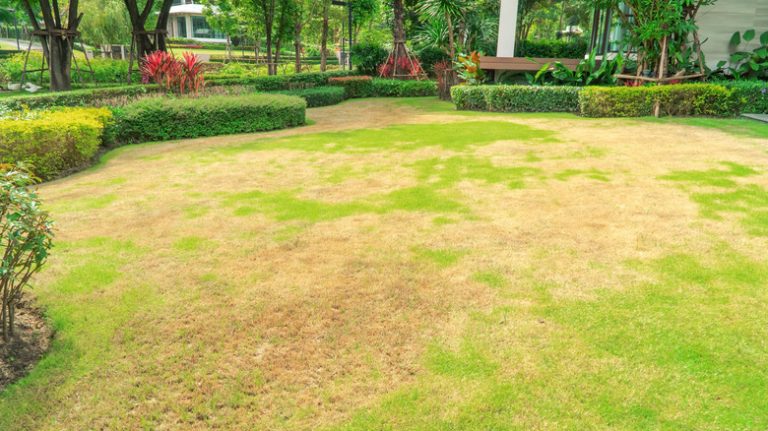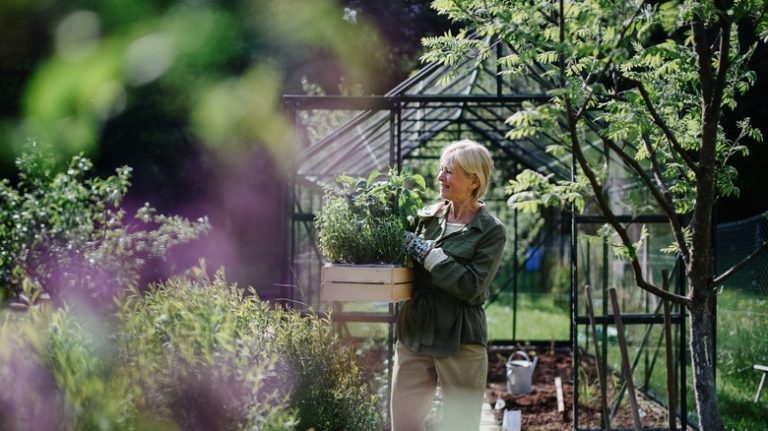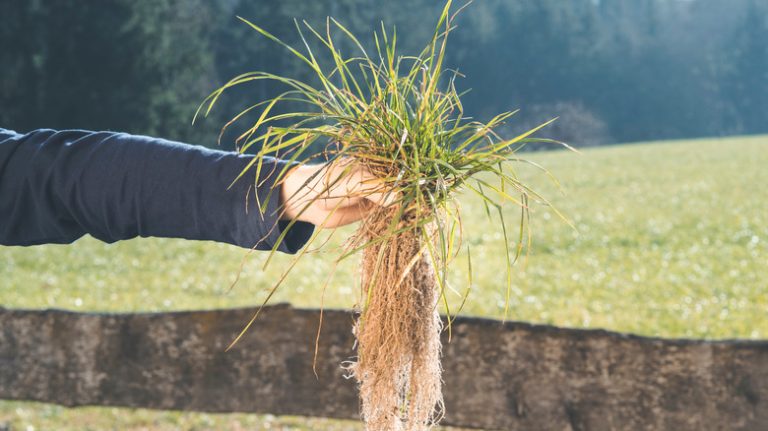Mosses grow in abundance all around the world and in a variety of unique conditions that are often inhospitable or outright prevent the proliferation of other plant life. Kew Royal Botanical Gardens notes that mosses are easily identified in damp conditions (both cold and warm) as well as in dry, desert regions alike. Moss is a fascinating and ancient plant that lacks roots and flowering structures, yet they make use of the photosynthetic process all the same. Instead, they cling to surfaces using features called rhizoids. Mosses are instrumental in regulating temperature in the soil beneath their growth, providing trees or other plants with either insulated heat or shade that helps maintain biodiversity and fertile growth in regions that are often inhospitable to prolific blooming in many plant species.
Yet, because of the success in growing virtually anywhere, moss can creep into places throughout the lawn that homeowners might find unappealing. In forested contexts, moss can invoke a sense of serenity and quiet, but in residential areas, the plant has more of a hindering effect on routine tasks, lifestyles, and schedules. It can do everything from making your sidewalk too slick to walk on to taking up your entire weekend with eradication plans.
Removing moss from the surfaces of your trees or surrounding soil, driveway, roof, or anywhere else around the home is a typical outdoor chore for many folks across all communities in the United States. With these simple approaches to moss removal in your arsenal, managing the growth of this potential yard blight is simple and highly effective.
What is moss?
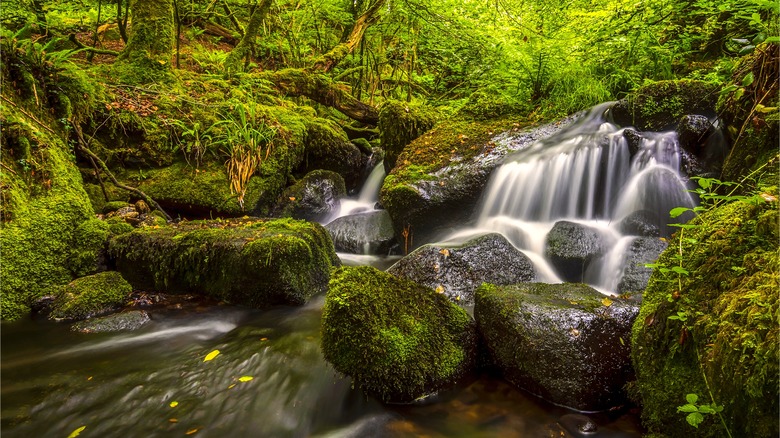
Moss is a fascinating plant variety. A member of the Bryophyta classification (along with liverworts and hornworts, as per MountainMoss), mosses grow together into massive colonies along the ground or up the sides of structures such as trees, walls, and other natural barriers. There are as many as 25,000 varieties of Bryophytes, and mosses make up the bulk of these unique plant types. They date back to around 450 million years ago and grow in virtually all parts of the globe, according to Kew Royal Botanical Gardens.
The Reykjavik Grapevine notes that moss is a major contributor of oxygen to the atmosphere, just like any other plant life that might exist in your local community. As such, the seemingly unending fields of moss that have come to dominate the landscape beyond the cities and towns of Iceland are ecologically essential to the island’s natural environment. In Iceland and elsewhere, moss provides moisture and ground cover that protects underlying root structures from both heat and cold. In northern regions, moss insulates the soil laying beneath its extent, providing a measure of warmth that allows other plants to continue to grow even in the face of extreme temperatures. In hotter regions, moss and the high moisture content that these colonies bring to the landscape provide a cooling effect that maintains hospitable conditions in the soil.
As a result of all of these features, mosses are an essential element in any natural landscape. Through their versatile inherent properties, they provide beneficial growing conditions in forests, steppes, and arid environments. It’s for these reasons that mosses seem to thrive, regardless of the prevailing climate and typical weather conditions in an area. They are versatile growers and make for a key feature in just about any natural landscape.
Moss as an aesthetic killer in the lawn
In the context of a front (or back) yard, moss can be an unsightly feature that should be removed from the equation. In many areas, mosses bring along additional moisture to the spaces beneath their growth, according to The Natural Navigator. This is beneficial in forest navigation and promoting a wild landscape of biodiverse foliage, but less so in the confines of a suburban neighborhood. This moss feature creates a slick surface and potentially kills off plants you want to grow due to the intense collection of increased moisture. Many plants that homeowners cultivate around their homes require moderate to well-draining soils, and the introduction of a moss covering can counter this goal. When growing succulents, for instance, Succulents and Sunshine notes that these plants are highly durable unless they are overexposed to water Overwatering can lead to root rot, which kills the plant. As a result, a succulent garden should be closely monitored to ensure that moss is not growing in the soil.
The same is true for other plants in your landscaping. Killing off or reducing the growth of certain plants in your yard can reduce the aesthetic value of your yard. Poor growing makes for a glum visual effect across the space, leading to slumping energy throughout the property. Removing this element can be a simple fix for what seems like a systemic problem across your garden areas.
After eradicating moss cover, you can add natural, woody mulches or use grass clippings from your most recent mowing to promote the opposite moisture-retaining effect (via Gardener’s World). Without this moss covering, you can make amendments to the soil that will provide fertile growing conditions and easy drainage for the plants you want to thrive on your lawn.
Chemical solutions and ferrous sulfate
Mabeline72/Shutterstock
Eradicating moss growth might be essential if you see the plant species expanding across your lawn. Moss growth in the yard signals a potential issue with drainage in the soil or health in the grass itself, according to Love the Garden. Moss growth in a section of the lawn can be a warning sign of other health issues that may continue to develop over time, even after you’ve removed the moss from your yard. A chemical solution is a great way to address moss growth while also focusing on maintaining the health of your grass. Ferrous sulfate is the most common option when using these approaches, and often this mixture contains added fertilizer that will help promote soil health and kickstart new grass growth.
Ferrous sulfate is the most effective option within this realm of moss-killing possibilities. It’s typically the active ingredient in moss treatment products that you’ll find in home improvement stores and works effectively when used according to the instructions on the packaging. It’s typically not a good idea to use ferrous sulfate (or sulfate of iron) on its own, though. Commercially available products use a mixture of powdered ingredients to deliver this solution to the lawn, but a direct application of just the active ingredient can be too harsh, leading to the killing off of both the targeted moss and your grass. This will negatively affect your lawn, forcing you to plant new seeds or buy sod to replace the dead patch. In the most extreme circumstances, you might need to amend the soil as well before planting fresh grass to account for the change in soil chemistry resulting from a heavy dose. All told, this chemical-based approach is highly effective when used correctly.
Natural and home remedies for moss growth
FotoHelin/Shutterstock
While often a common solution, moss control doesn’t have to rely on applying chemicals. Instead of using ferrous sulfate products, you can whip up a natural remedy with typical home goods in a flash. These produce the same overall effect and take less of a toll on the ecosystem and environment of your yard and surrounding community. And chances are you already have most of these ingredients in your pantry, meaning you won’t need to run to the store and pick up items you’ll only use a few times for this specific purpose.
Grove suggests one of two easy-to-use methods for moss removal. Mixing baking soda with water to create a natural and non-toxic solution will give you significant coverage over an affected section of your lawn. Combining 2 to 3 tablespoons of baking soda with 1 quart of water (and expanding the volume and measurements to fit your lawn’s needs, of course) gives you all you need to combat short-term moss growth issues. Grove reports that this method may not be effective for recurring or widespread moss proliferation, but will work perfectly well on new growth or moderately sized patches that have crept into your lawn.
Alternatively, a dish soap and water mixture can provide a more effective remedy for larger growth. A combination of 2 ounces of dish soap and 1 gallon of water provides the moss-killing power of any other effective product you might find. With either of these methods, you’ll need to apply the mixture to your moss problem on a sunny day, and then wait two or three more days to let the moss dry out before raking it off the lawn. Disposing of the mossy plant material in a way that ensures its spores can’t repopulate the area will give you the moss-free look and feel you are seeking.
Physical moss eradication techniques
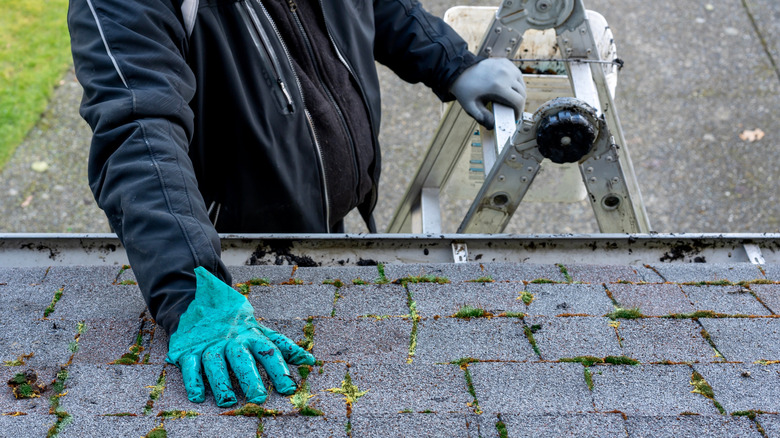
Andrea C. Miller/Shutterstock
Mosses aren’t always a sign of deteriorating soil conditions and grass health, though. Moss can, all on its own, create negative momentum in the continued health of your lawn because it can grow to a colony size that begins to outcompete the grass that you are hoping to continue cultivating. Moss isn’t an overly aggressive plant species, but these plants are opportunistic and will grow to encompass any area that provides an opportunity for establishment. Removing moss from the lawn may be all it takes to give your grass a new explosion of growth. This is particularly true for growth that has been caught early.
In these instances, physical removal might be all that’s needed to achieve your goals for the lawn. In other circumstances, a combination of moss-killing applications and the physical removal of leftover plant matter will yield the best results. Grove notes that one reason for the prominence of moss in a lawn is compacted soil. Dirt that’s been too heavily trodden can resist the healthy growth of grass roots. This leaves an opportunity for weeds or mosses to make their way into the lawn. Combined with a having a moisture rich section of the yard, moss will thrive in the space. That’s why one aspect of moss prevention is aerating your lawn’s soil. This task is often easy to accomplish and will make for a much healthier green space just outside your front door. The Grass People report that lawn aeration allows for free-flowing oxygen to penetrate farther into the soil and help with root respiration, essentially allowing plants to breathe easier. You can do so by spiking the ground with a garden fork or slitter. Afterwards, physical removal ensures that mosses and their spores are taken completely away from the lawn to prevent a return.
Maintaining proper soil health and a full lawn is an effective prevention technique
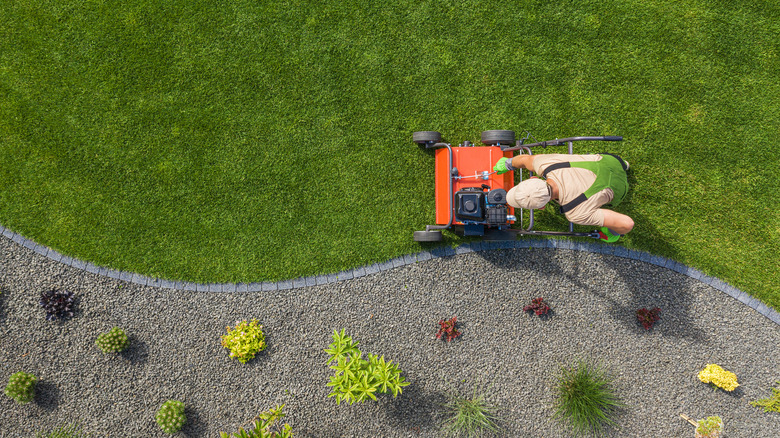
Virrage Images/Shutterstock
The Washington State University Extension reports that raking is an effective means of removing moss from your lawn. But the extension notes that the most effective tool for killing moss growth is through manual prevention methods. This is done through watering and fertilizing when appropriate, monitoring drainage, and using aeration techniques to ensure that moss never has a foothold to begin accumulating in the lawn.
A well-kept lawn naturally chokes out competing plant life — namely, those plants you don’t want to see growing in your space to begin with. A healthy lawn prevents the establishment of large weeds and can also act as a barrier to the growth of mosses. Healthy grass creates long-running chutes of root growth beneath the surface of the soil, and steady tufts of grass blades on top. Both of these plant structures act as a shield against the cultivation of other potentially invasive plants.
Mosses thrive in moisture-rich areas and begin to spread when conditions are prime for establishing a colony. But when there isn’t rain — or the grass stays dry for long periods of time — moss can shut down metabolically and wait until the conditions are prime again for it to grow (via Highland Outdoors). This means spores can lay dormant for months or years, waiting until your grass gets soggy enough to start spreading. Keeping any potential moss growth in this dormant phase is best done with an insistence on immaculate lawn care.
Moss removal for tarmac and paver segments
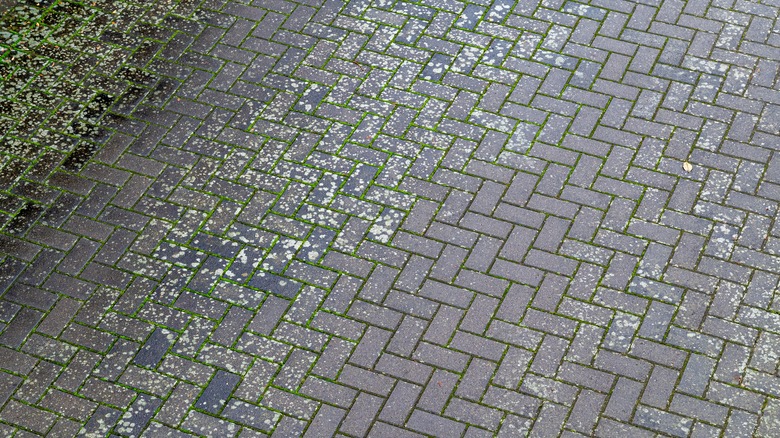
Ralf Geithe/Shutterstock
In addition to lawn moss, this plant can grow between the cracks and on the surface of walkways, driveways, roofing tiles, and more. Removing moss from these areas is important because it will ensure the continued beauty of your property. But visual appeal isn’t the only reason to tackle moss growth on a driveway, sidewalk, wall, or roof.
Your driveway in particular sees a considerable amount of foot traffic. Every day, when you and the rest of your family members leave to complete routine activities outside the home, this surface is walked across multiple times, with trips to and from the house. Because moss is a significant moisture retainer, a colony on the driveway or paver walkway from your home or garage can act as a slip hazard.
Driveway Paving reports that pressure washing can be an effective means of blasting away moss growth from the surfaces and cracks of a driveway. Pressure washing is easy to do and only requires a water hookup and pressure washer (which can be rented from home improvement stores). It is great for a quick fix, but this might not be the best option if your lawn is susceptible to moss growth. Pressure washing will blast away the plant, but the spores will linger, potentially settling on a nearby patch of lawn or concrete surface, starting the growth process and the need for removal all over again.
Instead, using a spray of bleach or vinegar or applying baking soda to the surface to dry out the moss will make wholesale removal more approachable. Alternatively, for loose moss that hasn’t penetrated the nooks and crannies of the walkway, boiling water can be an effective means of removing the growth.
Certain mossy growth can actually add visual appeal

Dezy/Shutterstock
While moss can be a nuisance, it’s by no means a plant that you’ll always want to eradicate from your lawn or other landscape. When used efficiently, moss can be an immensely beneficial addition to your soil in certain areas and functions. Clackamas Soil and Water Conservation District reports that moss is a fantastic addition to hilly landscapes that are particularly prone to erosion and general soil loss through water runoff or typically high winds. Moss is an effective ground covering option for these types of areas because they are durable and short plants that like to cling. They require different watering schedules and type of sunlight than grass and can thrive in shaded sections of any landscape. Adding this green ground cover to a shady part of your lawn can give your lawn a fuller look, filling in any patches of growth.
MountainMoss notes that mosses are a prized addition in curated gardens in many parts of the world, including some of the most pristinely cared for landscapes in Japanese gardens. The glistening green shade that mosses create as a result of their unique leafy structure and the moisture that’s retained within and beneath their coverage areas makes for a fantastic addition when used carefully and sparingly.
All this is to say that removing moss might be the best option for your lawn, but sometimes it can be used to boost aesthetic appeal. While it can signal problems in the soil chemistry of your home’s exterior space, the use of moss or its existence in your space doesn’t necessarily come with negative connotations. It’s beautiful if you choose to incorporate it into your landscaping, but can be a nuisance if it springs up without your planning or permission.
